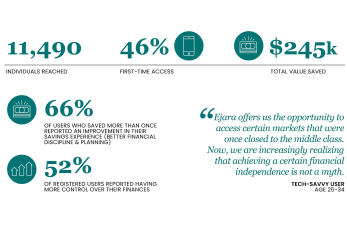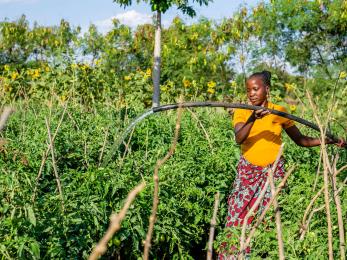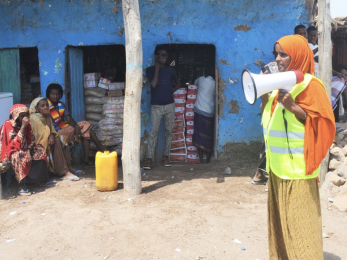Leveraging Tokenised and Fractionalised Bonds for Individuals in Cameroon
Across Africa, there are limited savings and investment opportunities that low-income individuals can access or afford. This is especially true in Francophone Africa, where usage of financial services is still among the lowest in Sub-Saharan Africa. For instance, data from the World Bank shows that adults in Kenya are two times more likely to store money using either a financial institution or mobile money account than those in Cameroon.
This, coupled with a significant mistrust in financial institutions, and prohibitive minimum investment requirements for high-yielding, low-risk investments such as government bonds, means that few individuals have access to opportunities to grow their savings with a cushion against market volatility and inflation.
In August 2022, we launched a pilot in partnership with Ejara, a Cameroon-headquartered crypto investment platform, to test a new savings offer: tokenised, fractionalised bonds as a savings plan for low-income individuals. The pilot brought down the buy-in minimum by more than a thousand times (from $1,600 to as low as $1.53), and reached over 11,000 individuals.

Insights in Brief
The pilot enabled access to a high-yield, low-risk savings product for many who did not have prior access. Nearly half (46%) of registered users surveyed reported that this was their first-time accessing such a savings product.
The pilot significantly improved the financial discipline, planning, and overall savings experience for repeat savers. Two-thirds of users (66%) who saved more than once reported improvements in their savings experience (better financial discipline and planning).
For informal entrepreneurs (merchants), having funds available for emergencies was the primary motivation for saving. We found that 64% of early withdrawals among merchants were because of emergency situations and 40% of those who did not withdraw early cited “emergency” as the reason for continued saving.
For tech-savvy users, rate of return and profits matter the most. Almost 40% of tech-savvy users reported that better interest rates and more profits would encourage them to hold the bonds to maturity. Additionally, 51% highlighted “the opportunity to invest” and “desire for an alternative financial strategy” as their key reasons for signing up.
On-ground agents were much more effective than online ads for user acquisition and activation. The activation rate for users acquired offline was 50%+, compared to just 17% for online ads. Additionally, customers activated offline were 7.5x more likely to save daily than those activated online.
This report is the last of a two-part series. The first blog outlined the pilot launch, our learning questions, and the hypotheses we set out to prove. This final report provides an in-depth study of the market need, the impact of the solution, and the key insights and learnings from the pilot.
Written by Njeri Muhia, Pilot Manager, Mercy Corps Ventures, and Timothy Asiimwe, Innovation Project Manager, Mercy Corps Ventures.

